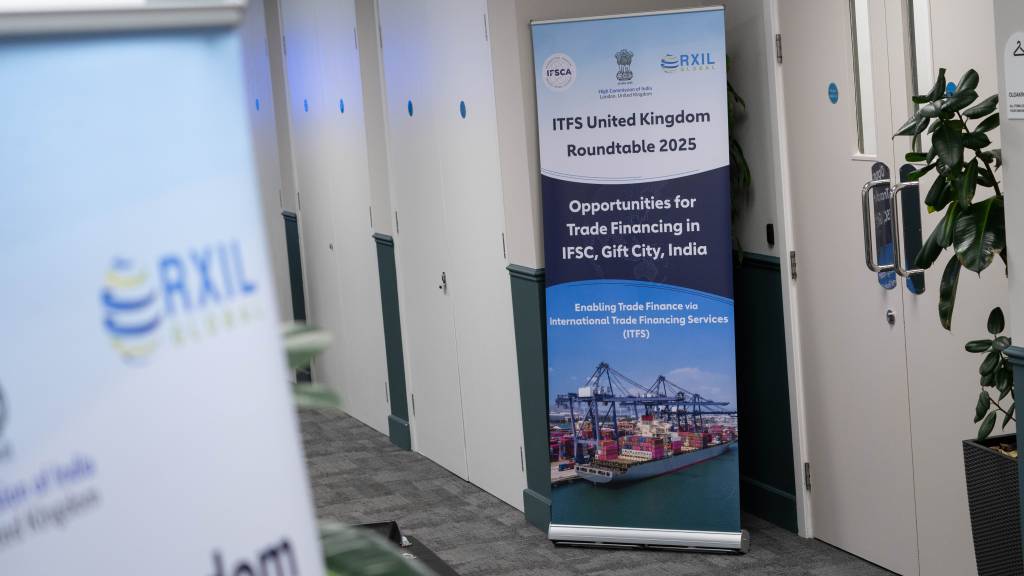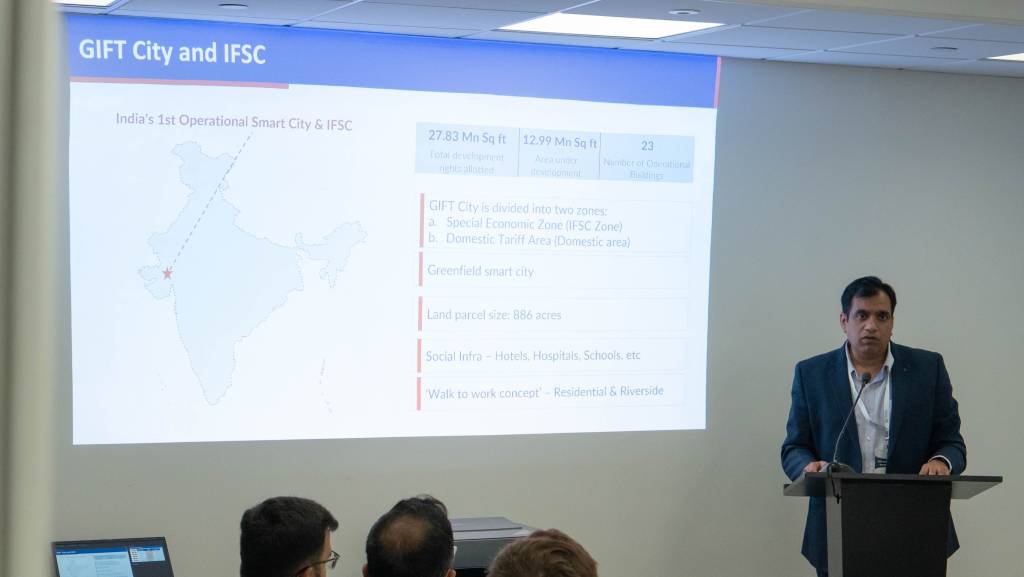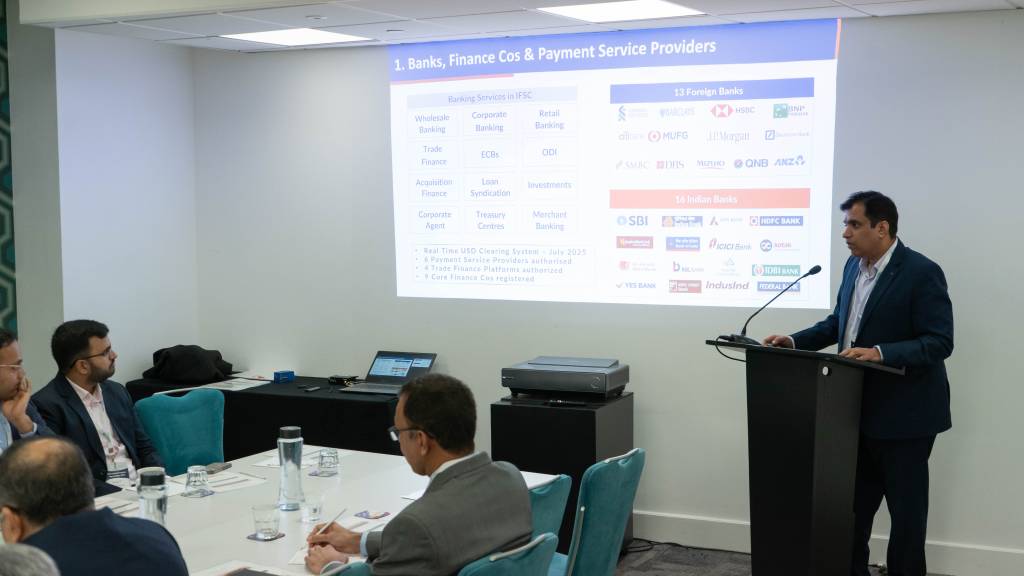VIDEO | BAFT CEO: Charting the course for transaction banking in a fractured world
Tod Burwell
Jun 06, 2025
 Carter Hoffman
Apr 11, 2025
Carter Hoffman
Apr 11, 2025

India is the world’s second-largest country by population yet only the fifth-largest by economy. But it is growing fast. Many experts anticipate that by the close of the decade, it will be the third or even second-largest economy.
To help it achieve this economic growth, the country’s government has introduced an array of policies in support of global commerce. Providing financing to meet the needs of importers and exporters is high among the aims of several of these.
The flagship initiative in the mix is Gujarat International Finance Tec-City, otherwise known as GIFT City.
At the ITFS United Kingdom Roundtable 2025, Deepesh Patel, Editor at Trade Treasury Payments (TTP), heard from a panel of experts on the opportunities for trade financing in GIFT City.

Trade is a critical pillar of any thriving economy. Recognising this, India has, over the years, implemented a number of policies to make it easier and more efficient for Indians to trade abroad and for foreign businesses to send their wares to India.
One program designed to boost domestic manufacturing is the Production Linked Incentive (PLI) scheme, which offers financial incentives to companies based on their incremental sales. Currently, the schemes are targeting a number of specific industries, including semiconductor manufacturing, high storage capacity battery manufacturing, high-efficiency solar energy modules, and technology development programmes.
Another measure has been the Insolvency and Bankruptcy Code (IBC), which was introduced in 2016. The code provides a unified framework for resolving corporate insolvencies in India and has improved creditor rights by allowing lenders to take control of a defaulting company and either resolve or liquidate it within strict deadlines. This code has made Indian corporates a lot more disciplined.
Other measures include the Goods and Services Tax (GST) regime, which has made the entire country one jurisdiction for taxation purposes, and Inflation-targeting and monetary reform, which have kept inflation around 2% over the last half-decade.
Given these trade and business-friendly measures, the macroeconomic rationale is set for creating a new kind of financial hub like GIFT City.
GIFT City is the result of India’s high-profile attempt to create a globally competitive financial centre on its own soil.
The city operates with a high degree of autonomy and has a complete exemption from India’s foreign exchange management regulations. As an International Financial Services Centre (IFSC), GIFT City is officially distinct from the rest of the country, sitting within a special economic zone that is physically located in the state of Gujarat.

On paper, GIFT City is governed by the International Financial Services Centres Authority Act, a parliamentary statute that transferred regulatory authority from India’s domestic financial regulators to a single, unified body: the IFSCA. The IFSCA operates independently from India’s typically fragmented financial oversight regime.
This has many benefits for firms operating in the city over other areas of India. For example, firms receive a number of tax incentives and enjoy other relaxed requirements, similar to those offered in Singapore or Dubai, that allow money to be brought in and out without requiring any official approvals.
This light-touch, innovation-friendly regime is particularly attractive to banks, insurers, fund managers, and fintech companies that are looking for exposure to the world’s second-largest market by population without being encumbered by India’s notoriously stringent regulations.
One of the most compelling areas of innovation, both within India and through its emerging international channels, is the development of digital trade finance platforms.
Domestically, India has already made notable progress in digitising trade credit access through the Trade Receivables Discounting System (TReDS). This electronic platform facilitates invoice-based financing by allowing small and medium-sized enterprises (SMEs) to sell their receivables to banks and non-bank financial institutions.
GIFT City aims to build on this foundation by internationalising the model. Officials want to mirror the TReDS platform in GIFT City with the same kind of regulations, and they expect a lot of banks, factors, and other financial companies to participate.
The ambition here is to connect Indian exporters—especially SMEs—with global pools of capital under a lighter regulatory regime and more flexible currency arrangements. This will lead to more competitive pricing and cross-border risk-sharing structures, things that are inaccessible to many firms under India’s current domestic regulations.
But there are more to the plans that just this. The ultimate vision is of a digital marketplace for the modern supply chain and its associated capital needs. This would include inventory financing and receivables-backed securitisation, among other offerings.
There are many benefits to an integrated system like this. For example, platforms within GIFT City are likely to experience greater liquidity partly because more investors will want to participate. Expanded investor participation will also lead to increased competition among financiers, driving prices down for those in need of financing.

The concept of GIFT City sounds great on paper, but how does its legal architecture, regulatory posture, and strategic orientation compare to other globally recognised financial hubs? Dubai’s DIFC and Singapore’s central banking and financial cluster are two commonly referenced benchmarks, both of which are known for investor-friendly legal systems and regulatory autonomy.
A key difference lies in legal jurisdiction and institutional independence. DIFC, for example, operates under an entirely separate legal code from the rest of the United Arab Emirates. It applies English common law directly, administered through an independent court system staffed by international judges. GIFT City, in contrast is still based on Indian law, but a version of it that is aligned with English common law. While GIFT City does not enjoy legal independence to the same extent, the fact that its regulatory framework is shaped by the IFSCA does provide a significant operational advantage over India’s traditionally fragmented domestic regulatory system.
From a strategic perspective, the scope of GIFT City is more focused than its peers. Both Singapore and DIFC are global in nature and serve multinationals with interests spanning multiple continents. GIFT City, on the other hand, aims to channel international capital into India. The centre’s purpose is not to become a catch-all financial entrepôt but rather to facilitate India’s integration into global trade and capital markets through targeted regulatory innovation. Despite this narrower orientation, GIFT City has attracted international players, many of which had no prior operations in the country, including several major banks from the UK.

Operational distinctions exist as well between GIFT City and its peers. A notable example is its treatment of currency. Unlike in Singapore or Dubai, in GIFT City there is no requirement to convert foreign currency to local currency for trade finance. Firms that primarily transact in USD, EUR, or GBP are likely to find this reduced friction enticing.
GIFT City is neither a carbon copy of Singapore nor an aspiring DIFC. Its competitive edge lies in offering something different: proximity to India’s growth.
If this all sounds promising, it’s because it is. But it would be naive to think that a project this ambitious would be immune to challenges.
One of the most pressing issues is the lack of reliable and accessible financial data on SMEs, which are the backbone of India’s export ecosystem, yet remain largely opaque to international financiers. Without robust financial disclosures, risk models remain underdeveloped, and international investors struggle to assess creditworthiness, which limits the inclusion of SMEs in global supply chain finance and deters capital flows that could otherwise support working capital needs.
A second, closely related challenge is the absence of a developed secondary market for trade finance assets. There is significant potential around the idea of securitising receivables or re-selling invoice-backed paper, especially if institutional investors can be enticed to join. However, the infrastructure needed for this is still nascent.
While banks and non-bank finance companies are eager to expand trade finance activities, the cost of holding capital against these exposures remains high. Making even modest adjustments to risk-weighting requirements or introducing insurance-backed credit enhancement could create much more lending capacity within GIFT City.
Other challenges relate to the interface between GIFT City’s offshore structure and India’s broader financial system. For example, because transactions in GIFT City are technically considered offshore, they are not classified as priority sector lending by the Reserve Bank of India (RBI). This inadvertently disincentivises domestic financial institutions from supporting SME exports through GIFT City. Further, while the centre benefits from special dispensations under Indian law, it remains to be seen whether this will lead to distortions in capital allocation or compliance standards between the domestic and offshore zones.
Access to insurance for trade finance exposures is another unresolved matter. Although GIFT City permits the use of trade credit insurance, it is not always available. Insurers with specialised capabilities (especially those offering asset-backed or structured risk solutions) are still in the process of building a presence within the centre, and until these are in place, banks may be unable to offload enough risk to free up capital for expanded lending.

These challenges, far from discrediting its ambitions, gift the city with a roadmap for its evolution. The centre’s long-term credibility and competitiveness will depend on how effectively these barriers are addressed—through regulation and sustained dialogue with market actors.
Addressing these gaps will require collaboration between all parties and a willingness to continually iterate.

Tod Burwell
Jun 06, 2025

Carter Hoffman
Jun 06, 2025
Trade Treasury Payments is the trading name of Trade & Transaction Finance Media Services Ltd (company number: 16228111), incorporated in England and Wales, at 34-35 Clarges St, London W1J 7EJ. TTP is registered as a Data Controller under the ICO: ZB882947. VAT Number: 485 4500 78.
© 2025 Trade Treasury Payments. All Rights Reserved.